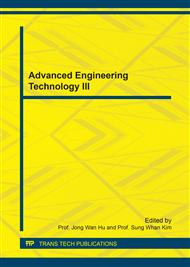p.155
p.161
p.169
p.175
p.181
p.188
p.192
p.200
p.206
Preparation and Study of a Type of Magneto-Rheological Materials Used in Vibration Control of Space Grid Structure
Abstract:
A type of Magneto-Rheological Materials (MRMs) was prepared. The off-state viscosity and the shear stress of the MRMs were characterized and studied by an advanced rotational rheometer system. A kind of Self-Decoupling Magneto-rheological (SDMR) damper was established based on these MRMs. An intellectual isolation system for grid structures was obtained by integrating SDMR damper and isolation device. The seismic whiplash effect of the top bent frame column and space grid roof of the hydropower plant could be reduced. Furthermore, the half stable increment method was proposed as the semi-active strategy. The results indicated that the SDMR dampers used at the grid roof supports setting plate rubber bearings can significantly improve the vibration performance and energy dissipation structure roof isolation system in different seismic intensity. In addition, these SDMR dampers can effectively reduce the lateral slippage of the plate rubber, so as to avoid failure or damage of the isolation system because of the transfinite horizontal displacements. Compared with the conventional damper only in case of multiple earthquakes, the damping force and adjustable multiple of this SDMR damper have better adaptability, and this SDMR damper provides a higher safety factor.
Info:
Periodical:
Pages:
181-187
Citation:
Online since:
June 2017
Authors:
Price:
Сopyright:
© 2017 Trans Tech Publications Ltd. All Rights Reserved
Share:
Citation:


